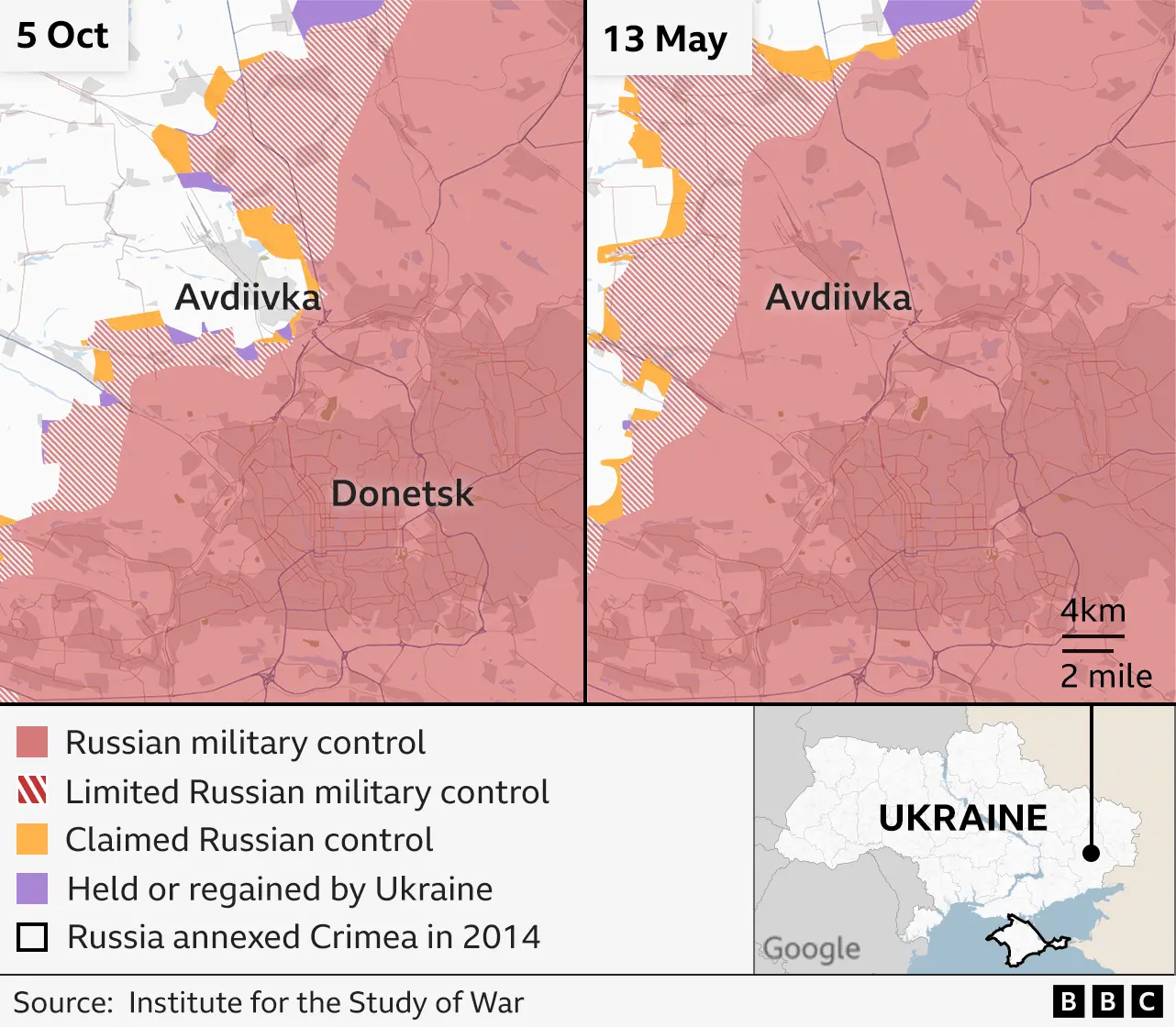Ukraine in maps: Tracking the war with Russia
 BBC
BBCFighting has raged in Ukraine since Russia launched a full-scale invasion in February 2022. Russian forces have made small gains in recent months but now Ukrainian forces have staged a counter-offensive into Russia.
Here is a recap of recent significant events and the situation in Ukraine.

Ukraine sends units into Russia
Ukrainian troops launched a surprise attack across the border in early August, advancing up to 18 miles (30km) into the Russian region of Kursk.
Almost 200,000 people were evacuated from areas along the border by the Russian government and President Vladimir Putin condemned the Ukrainian offensive as a "major provocation".
After two weeks, Ukraine's top commander claimed to control more than 1,200 sq km of Russian territory and 93 villages. The regions of Kursk and Belgorod have both declared a state of emergency.

The counter-offensive is seen partly as an attempt to force Russia to redeploy units from the east and relieve pressure on the beleaguered Ukrainian defences there, and partly as a bid to improve Ukraine's chances of a peace settlement.
Russian incursion north of Kharkiv
At the beginning of May 2024, Russian forces crossed the international border to the north of Ukraine's second-biggest city, Kharkiv. Several villages were seized and thousands of civilians fled.
Russia's main offensive has long focused on the eastern Donetsk region, but this was one of the most significant ground assaults since the start of the war and further stretched Ukraine's front-line defences.

The Russian push took place at the end of a four-month period when the US was not supplying weapons to Ukraine, due to a stalemate in the US Congress.
The issue was finally resolved at the end of April, when the US passed a $61bn aid package to provide missiles, artillery and air-defence systems to the Ukrainian military.
Ukrainian forces eventually held firm and even though the city of Kharkiv has come under repeated attack from glide bombs fired by Russian warplanes, it remains beyond the range of Russian artillery.
Russia grinds forward in the east
The incursion north of Kharkiv was some distance from the main front line in the east where Russia has continued its offensive operations and been edging forwards since October 2023.
Eastern Ukraine has been contested territory since 2014, when Russian-backed fighters seized large swathes of the eastern Donetsk and Luhansk regions.

Russia's biggest advantage is manpower and it has shown a willingness to throw soldiers at Ukrainian positions to gain a few metres at a time.
About 1,200 Russian soldiers were being killed or wounded every day in May and June, the highest rate since the beginning of the war, according to Western officials.
In recent days, Russian troops have made some significant gains to the north-west of Donetsk and claim to have captured the small town of Niu-York.
In response, Ukraine has ordered the evacuation of the city of Pokrovsk, with a local military official telling residents that Russian forces were "rapidly approaching".

The Russian advance towards Pokrovsk is the most notable change in control of the front line near Donetsk for several months.
The last major change came when Ukraine withdrew its troops from Avdiivka, just north of Donetsk, back in February after months of fighting.
Almost all of Avdiivka's pre-war population of more than 30,000 people have left and the town itself is almost completely destroyed.

To the north, areas around Bakhmut have remained a flashpoint and have endured some of the heaviest fighting of the war.
Although Ukraine gained some ground around Chasiv Yar, which is situated on high ground some 10km west of Bakhmut, Russian forces have since made further advances in the area.
Two and a half years of fighting
Russia's invasion began with dozens of missile strikes on cities all over Ukraine before dawn on 24 February 2022.
Russian ground troops moved in quickly and within a few weeks were in control of large areas of Ukraine and had advanced to the suburbs of Kyiv.
Russian forces were bombarding Kharkiv, and they had taken territory in the east and south as far as Kherson, and surrounded the port city of Mariupol.

But they hit very strong Ukrainian resistance almost everywhere and faced serious logistical problems with poorly motivated Russian troops suffering shortages of food, water and ammunition.
Ukrainian forces were also quick to deploy Western supplied arms such as the Nlaw anti-tank system, which proved highly effective against the Russian advance.
By October 2022, the picture had changed dramatically and having failed to take Kyiv, Russia withdrew completely from the north. The following month, Ukrainian forces recaptured the southern city of Kherson.
Since then, the battle has mostly been in the east of Ukraine with Russian forces slowly gaining ground over many months, while losing at least 50,000 troops - and probably many more.
By Dominic Bailey, Mike Hills, Paul Sargeant, Chris Clayton, Kady Wardell, Mark Bryson, Sana Dionysiou, Gerry Fletcher, Kate Gaynor and Erwan Rivault

About these maps
To indicate which parts of Ukraine are under control by Russian troops we are using daily assessments published by the Institute for the Study of War with the American Enterprise Institute's Critical Threats Project.
The situation in Ukraine is often fast moving and it is likely there will be times when there have been changes not reflected in the maps.
